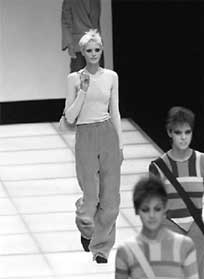The colour of fashion
 fashion czar Giorgio Armani has already done it. Gap and Nike are doing it. And the Dutch-based clothing house C&A is hoping to do it. Green fashion is finally coming of age.
fashion czar Giorgio Armani has already done it. Gap and Nike are doing it. And the Dutch-based clothing house C&A is hoping to do it. Green fashion is finally coming of age.
Environmental designer clothes no longer seems like a contradiction. And while designers stitch what Armani calls "the eco-compatible clothing of the future', environmentalists are glad that green ethics have finally hit the ultimate consumerist sector, the clothing industry.
From clothing made from undyed linen, organic cotton and hemp to undergarments made from recycled plastic water bottles, the range so far has been promising. Cotton is widely-regarded as a natural and, therefore, eco-friendly fabric. But while traditional cotton is grown on just three per cent of the world's farmland, it accounts for up to 15 per cent of global pesticide use and 7.5 per cent of artificial fertilisers. Therefore, the shift to using organic cotton could do away with a lot of environmental problems.
A new breed of artificial fibres is also gaining ground. Polyester, reinvented for modern use in fleeces and sportswear, can now be made out of 100 per cent recycled plastic, while Tencel, a newly-developed fabric which dries faster and keeps its shape longer than natural ones, is made from wood pulp entwined with artificial fibres. Armani's latest men's jeans collection features trousers and shirts in "ecological polyester and viscose' made from recycled and resin-coated plastic.
Then there is hemp, also known as "industrial strength linen'. The crop, which belongs to the same plant family as marijuana, was declared illegal in the uk in 1971. But licences to grow industrial hemp have again been granted since 1993. Hemp clothes are very durable and the plant needs no chemical inputs to grow. It's fibres can also be used for fashion accessories such as belts, wallets and bags.
Cotton, artificial fibres and hemp are doing wonders in the fashion industry and among the public today. But the question is how long will this conversion go? David Shah, publisher of Viewpoint , a magazine for the design and textile industries, believes it is here to stay. "Today's companies want to appear socially-responsible to consumers. They also know that sooner or later government legislation will force them along the path to non-polluting production methods,' he says ( Green Futures , No 19, November/ December 1999).
But Gabriela Lana, who runs Greenfibres, one of the few mail-order green clothing companies in Britain, thinks otherwise. While welcoming the interest of big fashion houses in green clothing, she remains sceptical of their motives: "If somebody like Armani makes people aware of how destructive growing conventional cotton is, then that's a good thing. But if he really applied environmental criteria to his whole production cycle, he probably wouldn't be able to produce 95 per cent of his collection.'
However, a few companies have managed to make the transition to sustainable materials and production processes, and still boost sales and profits. Patagonia, the California-based clothes manufacturer, and Globus in Switzerland are among the pioneers.
Patagonia started using organic cotton in 1996, after a rigorous life-cycle analysis of its materials revealed how damaging conventionally-grown cotton was in terms of pesticide use and affect on water tables and wildlife. They then began encouraging manufacturers of fleece; producing underwear made from recycled plastic, which are melted down and spun into fibres; and phasing out damaging finishing dyes such as formaldehyde.
Turning eco-friendly has not meant dwindling profits. Patagonia has a global turnover of us $180 million. But the environmental factor alone is not enough to sell clothes. Says Hal Thompson, Patagonia's product promotions manager: "Our analysis is that calling our clothing eco-friendly is not a good marketing tool. Customers are generally glad we are doing all these things for the environment, but at the end of the day they buy a product primarily on style, colour and price.'
As long as this remains the case, the onus will lie with retailers to blaze a trail in adopting eco-friendly fabrics before the public demands them. So far, this is the major challenge that the major chains have been slow to accept.
"Looking ahead, the first priority must be to counter the profound lack of awareness within the public of the social and environmental impacts of clothing throughout its lifecycle,' says Nick Robins of the International Institute for Environment and Development, uk . "The second is to develop a more collective response on the environmental front
